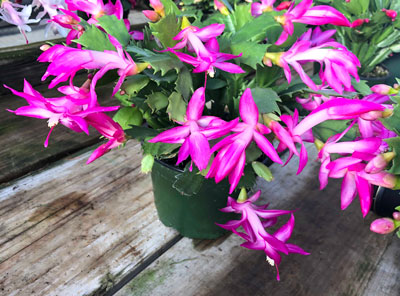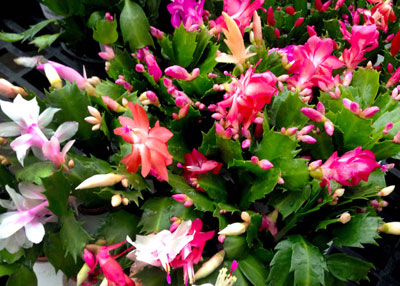A Plant of This Season

We’ve been growing this lovely holiday flower for generations, perhaps even longer than poinsettias.
Thanksgiving cactus blooms at the end of the fall heading toward Christmas, and since you’re seeing it in nurseries and flower shops right now, I thought I’d give you the clues to growing it successfully for future years of enjoyment.

Shortcourse About Thanksgiving Cactus…
• Botanically it’s Schlumbergera truncata.
• The closely related Christmas cactus is generally listed as S. bridgesii.
• Native to tropical rainforests of Brazil.
• Epiphytic, meaning that it grows suspended from tree trunks, much as bromeliads and orchids do.
• Requires a very porous planting medium, possibly 50 percent standard potting soil, 25 percent sphagnum peat moss, 10 percent finely ground pine bark mulch and 15 percent horticultural perlite.
• Unglazed terracotta pots are best. They dry out better between waterings, yet they provide enough weight (ballast) to support the plants which can become top-heavy with age.
• Require very bright light, but no direct sunlight from April through October. Sunlight in winter can be beneficial.

• Sets flower buds when nights are longer than 13 hours without interruption of artificial lights. As with poinsettias and mums, light destroys the flowering hormone that triggers formation of flower buds. To get your plant to come into flower around Thanksgiving you will want to give it total darkness for 13 hours each evening (and bright light in the daytimes) beginning October 1. Should you accidentally expose it to several minutes of light some evening during that period you will delay blooming by only one day – the process will not reset entirely.
• Keep your plant cool while it is in the bud-setting phase in the fall. High temperatures do not favor the best flowering.
• Feed with water-soluble fertilizer at one-quarter strength applied monthly spring and summer.
• Keep plant moist at all times, but never wet for prolonged periods, especially during the winter.
• New plants are started from cuttings taken from short pieces of stem sections 2 or 3 segments long. To ensure good aeration, lay them on perlite or sand that you keep consistently moist.
• You can allow mature plants to become rootbound. Repotting may not be needed for several years.
